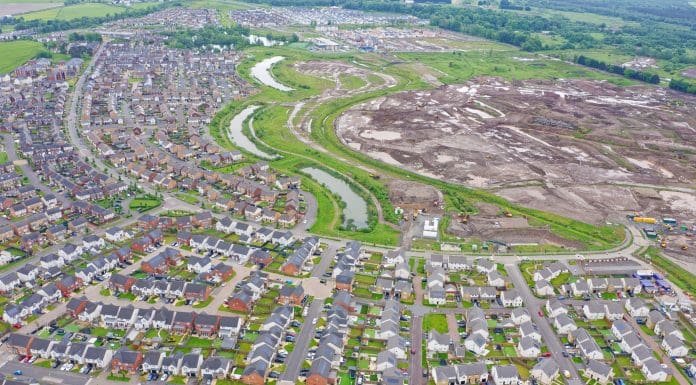Deputy prime minister and secretary of state Angela Rayner presented the plan for NPPF reforms to Parliament this afternoon, with a revised housing target
The new Government’s planned National Planning Policy Framework (NPPF) reforms come during the UK’s “most acute housing crisis in living memory”, according to Angela Rayner.
Presenting the NPPF reforms to MPs yesterday with housing minister Matthew Pennycook, Rayner revealed that the method used to calculate housing targets would be revised.
The calculation will go from a population-based model to a stock-based model, taking into consideration where house prices are “most out of step with incomes”.
Accusing the previous government of “caving into their anti-growth backbenchers”, Rayner also announced the reinstatement of mandatory housing targets, admitting that the proposed NPPF reforms would not be “without controversy- but this is urgent.”
The new national housing target is 370,000 homes a year
Building 1.5m new homes in five years was a key tenet of Labour’s campaign and the government still believes that the changes in the NPPF reforms will enable the housebuilding sector to achieve this target.
“Errors of the past” has led to the number of new homes expected to be built this year dropping below 200,000, according to the deputy prime minister.
Just a third of councils have a housing plan developed in the last five years and the old population model used to calculate targets was based on data from 2014, resulting in “all sorts of odd outcomes”.
“Arbitrary” 35% urban uplift has been scrapped
Every part of the country will be required to increase housing delivery under the new targets, although some areas have had their targets lowered accordingly.
London’s previous target of 100,000 homes has been reduced by 20,000- but Rayner was quick to deny that the new government was “lowering our ambition” for the capital.
The City’s own housing plan targets 52,000 homes, with 2023 managing to deliver around 35,000 homes.
Rayner warned local leaders that she would be willing to overrule plan-making if necessary
Writing to every council leader and chief executive in England, Rayner stated there was “not just a professional responsibility but a moral obligation to see more homes built”.
She also said that she would not hesitate to use intervention powers to deliver necessary housing; the department is already consulting on changing intervention criteria to maximise efficacy of minister intervention.
The NPPF reforms define “grey belt” land for the first time
The new classification of land for development was introduced by Labour earlier this year and was further explained in the NPPF reforms presented yesterday:
“For the purposes of plan-making and decision-making, ‘grey belt’ is defined as land in the green belt comprising Previously Developed Land and any other parcels and/or areas of Green Belt land that make a limited contribution to the five Green Belt purposes (as defined in para 140 of this Framework), but excluding those areas or assets of particular importance listed in footnote 7 of this Framework (other than land designated as Green Belt).”
This would include formerly developed sites such as car parks or petrol stations, as well as unused land on the edge of existing settlements or roads.
Local authorities will be required to prioritise grey belt land in their development plans if not able to meet their housing targets through brownfield development.
The Government does not currently know how much grey belt exists or how much housing it could support. More data is needed to maximise housing delivery, as Nimbus’ Paul Davies comments:
“Knight Frank has reported that 100,000 to 200,000 new homes could be built on grey belt sites, and others have produced similar findings showing just how valuable this land can be in meeting housing targets. However, knowing the specifics of each of these sites will be the key to unlocking the housing potential there.
“Access to data insights such as these will not only speed up developing on these grey belt areas but will also add some much-needed clarity to the potential that grey belt offers. Equally, other information will give insight into historical uses or planning information to further inform the bigger picture.
“The government, developers and the rest of the supply chain need to work in partnership to gather these insights and deliver housing targets – it’s not enough to work in isolation anymore if we want to collectively make change.”
The housebuilding sector welcomed NPPF reforms, but wondered about efficacy
Anna Cartledge, legal planning partner at law firm, Shakespeare Martineau, said: “Planning policy in the UK has remained stagnant for years and close attention has been desperately needed. Increasing housing targets is one thing, but it will be critical that local planning authorities are provided adequate support to manage the updated policy process, or any new plans will fall completely flat.
“Local authorities will also be required to review greenbelt protections that fall within their remit, with Rayner referring to a “more strategic system for Green Belt release”. This controversial area may quickly prove toothless as any review will remain at a local level and could simply involve the removal of the previous amendment from December 2023, which stated that reviewing or altering greenbelt boundaries was optional to allow for building in exceptional circumstances as opposed to a matter of course.
“Importantly, Rayner made it clear that where development does occur within the Green Belt, there will be “golden rules” in place; including the provision of 50% affordable housing with a focus on social rented tenure.”
The post Rayner sets new target of 370,000 homes in NPPF reform appeared first on Planning, Building & Construction Today.


